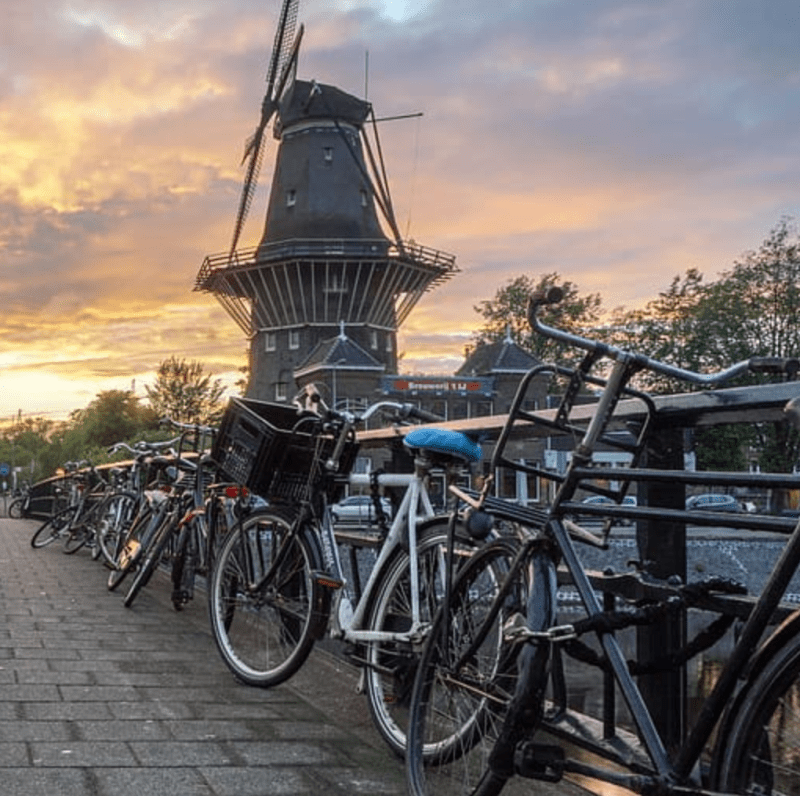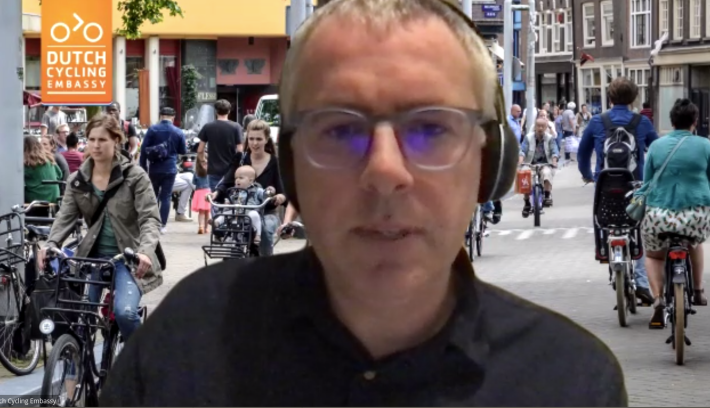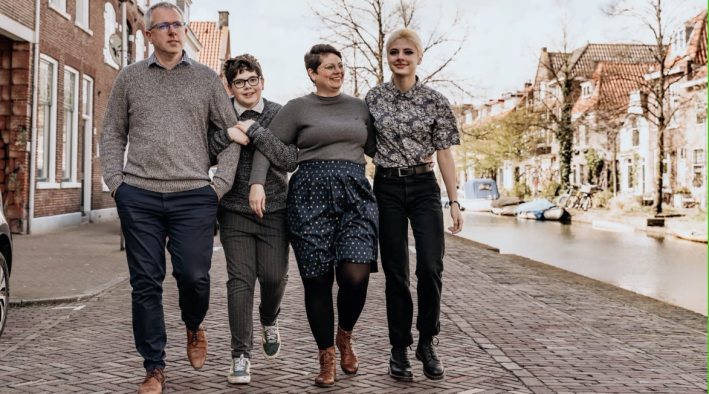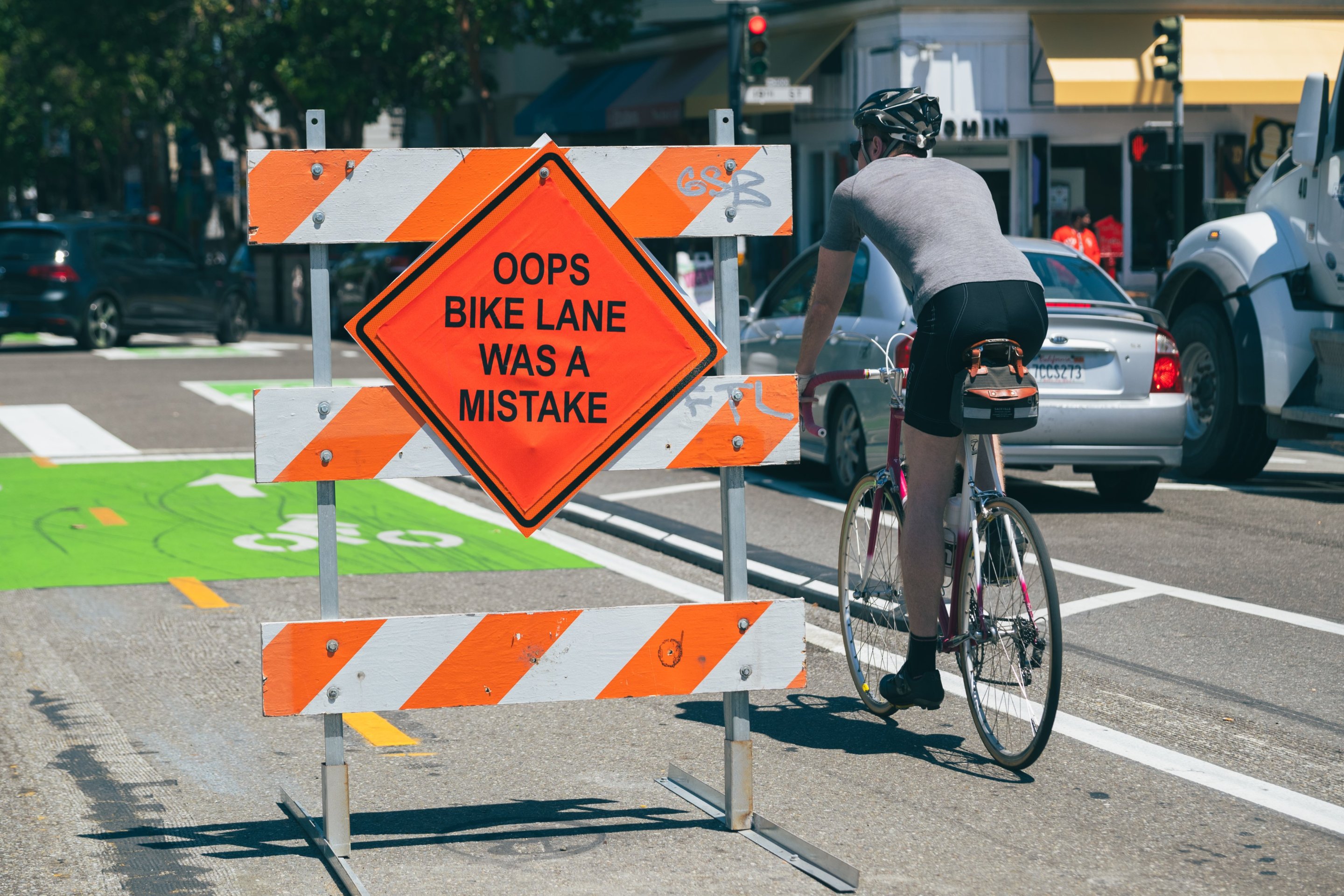Q&A: Dutch Safety Experts Coming to San Francisco
3:02 PM PDT on September 1, 2022

A bike path in Amsterdam. Image: Px Here via Creative Commons
Next week, Sept. 5-9, a delegation of Dutch transportation and safety experts will be in San Francisco meeting with locals and offering their take on how to make streets safe and transit more usable. Streetsblog had a talk with one of the conference organizers, Chris Bruntlett, Marketing & Communication Manager for the Dutch Cycling Embassy, about what the Bay Area can learn about mobility and urban design from the Netherlands.
***
Streetsblog: So what's this upcoming conference about? Why are the Dutch coming to San Francisco?
Chris Bruntlett: It's primarily an economic trade mission. The Netherlands has identified sustainable mobility and cycling expertise as potential export products to the American market.
SB: Well, the Netherlands certainly has a better track record for mode share and safety. But how do you 'export' safe bike lanes?
CB: The hope is to introduce Dutch consultants and connect them with local partners in government, at public transit agencies, and to other consultants who may want to partner. We want to inject Dutch expertise to your part of the world, whilst also potentially creating some economic opportunities for Dutch companies.
SB: But this isn't just about new ways to make money? I mean, I've known you a long time--you've dedicated your life to safety. And the Dutch people seem eager to talk about safe practices whether or not there's money involved.
CB: The Dutch Cycling Embassy walks this fine line between knowledge-sharing and economic development. We exist to do both. Generally, we get our funding from the Ministry of Infrastructure to spread Dutch knowledge and expertise, but we also get our funding from our network of 95 organizations that work in the field of cycling from the public sector, like municipalities and universities. But some are private consultants that are looking to open markets in every corner of the world, so we also exist to connect them with potential customers to promote their knowledge and expertise internationally.

SB: Churchill is attributed with saying that "Americans will always do the right thing after exhausting all the alternatives." The Dutch have spent decades figuring out how to build safe streets, and they've obviously figured it out. Yet I continually hear from officials in the Bay Area that they need to "experiment" with street designs, instead of just stealing best practices from overseas. In fact, often they just keep installing the same failed designs, like mixing-zone intersections, or door-zone lanes, over and over again.
CB: To echo what you're saying, yes, a lot of cities don’t learn from their own mistakes, let alone other people’s mistakes. The Netherlands made all the mistakes in bad, dangerous street designs in the 1970s, 80s, and 90s. You don't have to. The Dutch started on this process to multi-modality and reduced car dominance much sooner than everybody else, so they're much further along. They’ve got books and principles and best practices that we’re now able to share with other cities and regions. It's not necessarily a copy-paste situation, where we’re trying to make every city like Amsterdam, but we’re stressing intersection designs, combining public transit and cycling, and other things that can work in any context. It's a question of taking the ideas and translating them and making them work on your own streets.
SB: "But the Netherlands is just so different!" they say.
CB: We shouldn’t reject ideas because the Netherlands has a different history and culture. At the end of the day, it’s about building better cities that aren’t solely designed around one mode of transportation to the detriment of every other goal.
SB: There was a recent editorial in our sister publication in Boston that tried to paint the Netherlands as a place where not all voices are heard. Did you see that?
CB: (Laughs) Oh yeah.
SB: How was it received in the Netherlands?
CB: I think there is a nuanced conversation to be had; a discussion about how we can't just cut and paste everything from the Netherlands and, yes, the American context is different. But that was lost in some very blanket statements about pedestrians not existing in Amsterdam and that the transportation system doesn’t work for immigrants. The opposite is true.
SB: Having walked around Amsterdam and Rotterdam for many hours myself I just had to laugh at that pedestrian statement.
The Dutch have a saying: Niet gelijk, maar wel gelijkwaardig (Not the same, but worth the same).
— Melissa & Chris Bruntlett (@modacitylife) September 1, 2022
It is something that transcends their culture onto their streets: regardless of age, income, ethnicity or physical ability, everyone is afforded the same respect, dignity and safety. pic.twitter.com/8jdOmttsbi
CB: People who have been to the Netherlands understand that it is a society that is very egalitarian and inclusive. They're not perfect, but it's better than most places. To suggest that the United States does anything better on this matter is a stretch. And that’s me putting it diplomatically. I don’t know if there’s a follow-up or a rebuttal to be done or we just never mention it again.
SB: I'm for never mentioning it again. I know you've written quite a bit about what it's like for kids growing up in the Netherlands versus car-centric cities in North America. You posted something about “What Americans call 'free-range parenting,' the Dutch simply call 'parenting.'” Can you elaborate?
CB: It's something you’ll notice as soon as you arrive and step outside of a train station in the Netherlands; there are so many children and teenagers on the cycling infrastructure. They move around without mom or dad having to supervise them. It’s one of the many, many benefits of having a cohesive cycling network. Dutch children are amongst the healthiest and happiest in the world. And they aren’t counting down the days until they get their driver’s license so they can get around. As a father of two who relocated to the Netherlands three and a half years ago, I can speak to how the cycle lanes gave them an autonomy that they never experienced in Vancouver or any other place they lived. Suddenly they could go to friends' houses, school, or anywhere within our city on their own.
SB: Just within the city?
CB: Actually, they can also go to neighboring cities by train on their own. Car-based cities exclude so many people, not the least of which are all of us for the first 16 to 18 years of our lives. Bicycles and alternatives to cars give kids the opportunity to get around on their own. Otherwise, they’re growing up in the back seat of a car. The Netherlands permits them to make mistakes, meet friends, and just be children. It’s one thing that we don’t talk about enough when we talk about the rise of the automobile in North America. The freedom it promised us was taken away from a lot of demographics, including our own children.
SB: I wonder how much that contributes to body and mental health issues in America.
CB: It’s an underappreciated and understudied contributor. My wife Melissa and I wrote about this in our book Curbing Traffic. To practice good mental health, to be happy, and to avoid some types of depression, we need regular movement and exercise. We need to move our bodies, to access social contact and nature. We need to surround ourselves with trees and lakes and rivers. Good urban design lets us easily get to places that aren’t super stressful, asphalt jungles. When we talk about the mental health crisis in countries around the world we should also be talking about how the design of our cities impacts that.
SB: So how did you and your wife Melissa end up the voice of Dutch cycling expertise?
CB: Melissa and I were working in cycling advocacy in Vancouver. We did regular articles for a local publication, The Daily Hive. One day it just occurred to us that we’ve never been to the Netherlands and we should probably visit, so we wrote five articles about what Dutch cities could teach Vancouver. That eventually became Building the Cycling City, our first book. That took us on a speaking tour. We caught the attention of Mobycon and the Dutch Cycling Embassy. And that landed us these full-time roles exporting and promoting the Netherlands as the great cycling nation that it is.
SB Is your new home of Delft still heavenly to you?
CB: Very much so. It's three and a half years later, and we still feel as if we're in a honeymoon period with this city. We have this great connection to the streets. It's a small town and it's small-town living, but it also has this connection to big metros like Rotterdam and Amsterdam. The Netherlands provides us the ability to live without a car quite comfortably, both in terms of the built environment and the natural environment. We can get out to the forest or the beach with ease. The connectivity with the rest of Europe is also quite special and we can hop on a train to neighboring countries. We couldn’t be happier.
SB: Great. I look forward to talking more about all this. See you next week in San Francisco.
CB: See you next week.

For more on the Dutch Cycling Embassy's tour of California, click HERE. Or check out the information page for the overall trade mission.
Read More:
Stay in touch
Sign up for our free newsletter
More from Streetsblog San Francisco
Valencia Merchants to SFMTA: We Want Curbside Protected Bike Lanes
Valencia merchants association strengthens support for getting rid of the failed center-running bike lane and replacing it as soon as possible with curbside protected lanes
S.F. Fire Apologizes for Tweeting About Imaginary Bike Rule
There is no rule in California that says cyclists have to ride single file




